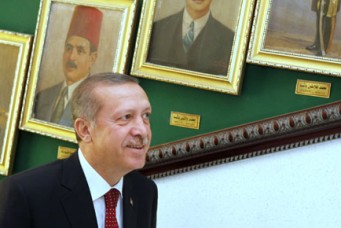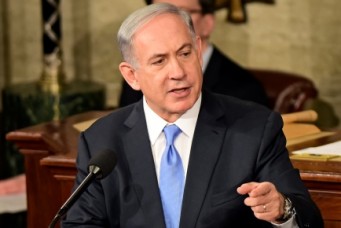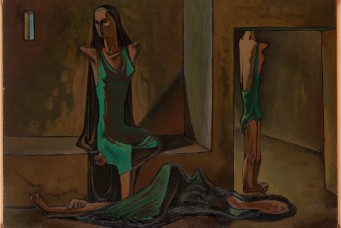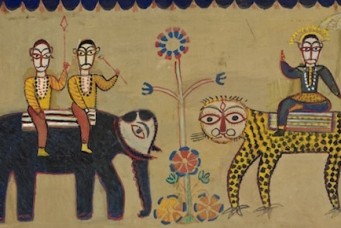The Art Effect
Art in our age is more than the Mona Lisa. The construction of major new museums like the Mathaf Arab Museum of Modern Art in Qatar and even an outpost of the Louvre in Abu Dhabi reflects the expansion of a global civil society.

Portrait of Mohamed Darouich Al-Allousi, 1924, by Abdul Qadir Al-Rassam. Mathaf Arab Museum of Modern Art
Sheikha Al-Mayassa bint Hamad Al-Thani of Qatar ranked first on the “Power 100” for 2013, a widely noticed list of influential art world personalities assembled by the British journalArtReview. Such compilations tend to provoke more eye rolling than hand-wringing from insiders, but unlike conventional art criticism, the “Power 100” articulates an implicit theory of art’s effects as an agent of globalization. In the case of Sheikha Al-Mayassa, two kinds of power are at issue. The first is purely financial: in 2013 the New York Times reported that, both on behalf of her family and in her capacity as the chairwoman of Qatar Museums, the sheikha controlled an annual art acquisition budget estimated at $1 billion. When compared with the official budget for buying art at New York’s Museum of Modern Art, which was reported to be $32 million for fiscal year 2012—though this number is significantly expanded through private gifts organized in conjunction with museum curators—the magnitude of the sheikha’s pure financial power in the art market is stunning.
In the same New York Times article, Sheikha Al-Mayassa made a statement indicating a second modality of power that, while more difficult to quantify, ultimately surpasses brute financial force in its significance: “My father often says, in order to have peace, we need first to respect each other’s cultures… And people in the West don’t understand the Middle East. They come with Bin Laden in their heads.” Currently, Qatar Museums encompasses major institutions devoted to conveying a more complex image of Middle Eastern culture well beyond Western assumptions regarding Islam: they include the Museum of Islamic Art, the Mathaf Arab Museum of Modern Art, and the Orientalist Museum. With plans for an eventual total of some twenty institutions, it is no wonder that the website of Qatar Museums proclaims Doha a “Capital of Culture.” This extensive cultural program should be understood as one element of a multi-pronged Qatari strategy aimed at expanding its global influence through, first, innovative and proactive forms of direct regional diplomacy—working as a mediator of Middle East conflicts, capable, for instance, of balancing such fractious rivals as Iran and the United States—and second, by wielding soft power, of which the development and globalization of the Al Jazeera network is the most prominent example.
Civil Imagination
What kind of soft power does art possess? In the disciplines of art history and criticism there is a strong tendency to see individual artworks as the privileged vehicles of art’s power. In other words it is a discrete work’s form, content, and socio-historical context that is responsible for generating its meanings as well as its political effects. In my opinion, the source of art’s soft power—how it might, for instance, become instrumental in causing an average Westerner to think of Qatar as an enlightened center of art tourism as opposed to associating it, as the sheikha would deplore, with Muslim terrorism—must reach beyond any individual artwork to consider the ideological effects of art in general, specifically art’s strong association with creativity, freedom, and open debate. Regardless of its particular properties, then, any individual work of art shares in such general ideological precepts and, consequently, may participate in the formation of civil society, in the literal and aesthetic sense of putting into form new spaces of public interaction.
The photography theorist and curator Ariella Azoulay has forcefully argued that there is a “citizenry of photography.” What this means to her is that by entering into the social transaction of photography—by taking a picture or allowing one’s picture to be taken, for example—a set of rights and responsibilities are presumed among all who participate, whether willingly or not. As an Israeli activist in support of Palestinian rights, Azoulay sees progressive political potential in this virtual or imagined mode of citizenry, whereby, for instance, Palestinian subjects who do not enjoy the rights of citizenship in their homeland under Israeli occupation, may in fact make claims to a global public through their belonging in the “citizenry of photography.” This is because, unlike many if not most art historians or critics, Azoulay does not believe that a singular and stable meaning is dictated by any particular image. Instead, she advocates a mode of looking, in which assignment of significance to a photograph is a negotiation that must be richly informed by social and historical research, interpretation, and political debate.
For instance, Azoulay has compiled and analyzed an archive of photographs painstakingly assembled from various sources that represent the destruction of Palestinian houses, from the birth of the State of Israel to the present day. Her analysis of these photographs is meant to construct a fugitive and habitually repressed history of Israeli policy. In short, Azoulay argues that photography calls for (and requires) a civil imagination in which images are understood as commemorating a particular social encounter, not just capturing an aesthetically gripping “decisive moment.” And indeed we could call Sheikha Al-Mayassa’s policies for the collection and exhibition of art in Qatar an act of civil imagination meant to recode Arab identity.
What I describe as art’s expansion of civil society may seem very close if not identical to what a media network like Al Jazeera aims to accomplish. I think we must include art as one component among many within global projects of national and regional self-assertion. These include most prominently networks such as China’s CCTV and Russia Today, which broadcast news from a national perspective in multiple languages around the world, as well as popular culture powerhouses such as the Bollywood film industry in India, or South Korea’s booming music industry.
As an assertion of civil society, however, art has three related qualities that neither news media nor popular culture possess in the same configuration. First, art carries with it a strong sense of history, both in terms of the distinct traditions of its own aesthetic strategies and devices (such as the history of painting), and its intimate relation to deep cultural and national traditions (as in the history of Indian sculpture). To make art today is thus to participate in a project as old as human life, which is nonetheless directed toward the conditions of the present. While from a certain perspective this dimension of art is so obvious as to be banal, its significance is enormous, and, I think, often overlooked.
A second distinctive quality lies in art’s association with accumulation. What we now call art from other eras and cultures around the world where our modern Western concept of the artwork may not have existed indigenously is perhaps better understood as mobile signs of wealth or prestige of various sorts—which is asserted through accumulation or through association with another “spirit” world (of ancestors or gods). Today the equivalent of such prestigious display takes the form of private collections and public (or civic) museums. Finally, third, art communicates through assuming some form of objectivity—even if, as Conceptual Art of the late 1960s and 1970s claimed, this form of objectivity complicates the nature of our common-sense idea of coherent objects by de– or re-materializing artworks as text, or photographic documentation, or ephemeral performance. This last capacity—to communicate through objects—consists in one of art’s greatest contemporary political capacities, which is to self-consciously or recursively perform as a commodity. In a world of rampant and continuous reification, art is a type of commodity that, since the emergence of modernity, has been dedicated to displaying rather than hiding the conditions of its objectification.
Because of its ancient historical identity as a mark of prestige subject to—or even requiring—accumulation, control over art has always been energetically pursued by elites, even as prevailing assumptions consider art unworldly. In a globalizing world this is equally true in the developed nations of Europe or North America as it is elsewhere, though the particular shape that art’s gambits will take vary from place to place. It is nonetheless perfectly plausible to define the contemporary globalization of art as the effort of a global super-elite—the transnational one percent—to extend an inter-connected network of museums, biennials, and art fairs into their own national economies as a mark of “civilization,” not so different from the competition in seventeenth-century European courts to reproduce the splendors of Versailles. And indeed, it seems evident that this is a major motivation for the extensive cultural program in Qatar, as well as in neighboring Abu Dhabi.
It is under such conditions of elite control, however, that the civic pretensions of art can become insidious—the promise of a civil society in formation can collapse into little more than an alibi veiling an autocratic state (or, as in the United States, an economically exploitative financial elite). Indeed, the question of the globalization of art might be posed as a constant oscillation between two opposing positions: the consolidation of power among transnational financial and governmental elites assisted by their association with art’s presumed public good, and the activation of art’s capacity to produce a genuine civil society through the expression of “civil imagination” as specified by Azoulay.
“We have Transitioned”
Another of Sheikha Al-Mayassa’s statements to the press—one that might have been uttered by any cultural patron from around the world—exemplifies the potential of a specifically global civil society. In an international conference on art and ideas in Doha in 2010 she stated: “Qatar wants to be a modern nation, but at the same time we are reconnecting and reasserting our Arab heritage.” Because of art’s close association with cultural heritage (an association that neither media networks nor popular culture can assert with the same authority), it possesses a powerful effect of localization within a global world. It can, in other words, help to constitute an Arabmodernity—or for that matter a Chinese modernity, a Brazilian modernity, or an American modernity. This emphasis on artistic heritage is certainly one of the reasons there has been such an extraordinary boom of museum-building during the era of globalization. The Economist, for instance, reported in 2013 that, “according to the current-five year plan, China was to have 3,500 museums by 2015, a target it achieved three years early.” While there has been widespread bemusement at the fact that many of these Chinese museums remain without a program, their construction demonstrates a commitment to culture as a form of economic and diplomatic development.
Similarly, in the spring of 2014 the Art Newspaper reported that the Kingdom of Saudi Arabia will spend $1.7 billion to build 230 new museums. It is particularly striking that these museums will focus on developing archaeological sites throughout the country, while also devoting attention to contemporary art. As Prince Sultan bin Salman bin Abdulaziz Al-Saud, head of the Saudi Commission for Tourism and Antiquities, stated: “We have entered a new age. We have transitioned. Antiquities are the seat of a continuum to bring the life and history of Saudi Arabia closer to the hearts and minds of the people of the Kingdom—particularly the young.” It is precisely such a historical continuum—from antiquities to youth culture—which art can organize.
Such vast museum construction programs, particularly in Abu Dhabi, have inspired some artists to publicize the discrepancies between lavish museums and the conditions suffered by migrant workers who typically build them. Gulf Labor is an international coalition of artists who, as their website states, “are working to ensure that migrant worker rights are protected during the construction and maintenance of museums on Saadiyat Island in Abu Dhabi.” They have accomplished this precisely through using the visibility of art as a civil forum to successfully publicize how cultural development is often accomplished by profound economic exploitation. Their focus is on projects being designed by ‘starchitects’ for the Saadiyat Island cultural center, the Louvre Abu Dhabi designed by French architect Jean Nouvel, the Guggenheim Abu Dhabi designed by Canadian-American architect Frank Gehry, and the Performing Arts Centre designed by Iraqi-British architect Zaha Hadid.
Gulf Labor has used at least three strategies in their activism: 1) they have deployed art by commissioning one artist per week over a year-long project to create a work on the topic of Gulf labor conditions that is widely disseminated through an email list and archived online; 2) they have organized live actions at the Guggenheim Museum in New York in collaboration with other activist groups in which guerilla artworks were placed on walls, manifestoes and brochures were distributed, chants related to the conditions of migrant workers erupted; and 3) they have conducted independent research on the conditions of migrant laborers working on Saadiyat Island, issuing a report in 2014 that among other things called attention to how they typically risk losing family land used as collateral when taking out loans to pay recruitment fees charged in their home countries.
In this essay I have pointedly avoided taking individual art objects as the vehicles of art’s globalization, emphasizing instead a texture of institutions and stakeholders who produce the specific contours of a global art world—of an ideological realm of “art effects” in general. But it is important at this juncture to emphasize that the activist procedures of Gulf Labor—networking (the weekly artists contributions released sequentially and then archived online), performing (through, for instance, their guerilla actions at the Guggenheim in New York), and researching (in their fact-finding mission to Saadiyat Island)—are absolutely consistent with the form and content of global contemporary art.
In the late 1960s and early 1970s, a number of artists in the United States, Latin America, and Europe pointedly challenged the status of the artwork as a self-contained object and rendered it as an effect of discourse (encompassing, as in Michel Foucault’s definition of the term, not only language, but configurations of images as well as institutional behaviors). Such work, labeled Conceptual and continuing in various transformations and under various labels and designations to this day, pioneered all three of the strategies I associate with Gulf Labor: first, collaborative forms of networking including collective publications or projects such as those of the Art and Language Group in London; second, a broad emergence of performance-based art which the French critic and curator Nicolas Bourriaud has influentially designated as “relational aesthetics,” in which the artwork consists of a set of social interactions rather than a physical object; and third, the widespread introduction of research into art practices as in the work of pioneering conceptual artist Hans Haacke who famously traced the tangled and obscure ownership of a network of tenement apartment buildings in lower Manhattan as a kind of “social sculpture” in a piece entitled Shapolsky et al., Manhattan Real Estate Holdings, a Real-Time Social System, as of May 1, 1971. The expansion of the artist’s role demonstrated in Gulf Labor’s activism thus belongs to a properly art-historical genealogy in which art objects themselves have been expanded.
The globalization of art takes place, like many other global dynamics, as a negotiation and conflict over the control of civil society—largely between patron elites and the capacity for art (and with this general term I mean to encompass not only artworks but also artists, institutions, critics, historians, and publics) to imagine new forms of commonality. What distinguishes this struggle in the realm of art is its deep association with heritage. Indeed, it is worth recalling in this regard the statement made by Prince Sultan about transition. This dizzying and seemingly paradoxical continuum—between ancient history and contemporary youth—is precisely art’s global terrain, not only in Saudi Arabia but around the world. Art has the capacity to localize international forms of modernity or modernization by introducing, for instance, the ancient into the contemporary, and this localization has an enormous value in “branding” nations, giving them important currency and soft power in a competitive global economy.
It is the challenge of art’s globalization that the very same artifacts may be used to bolster opposing effects: as public relations for elites on the one hand, and as the ground for political claims from the disenfranchised populations on the other. As a material practice, art has always given form to beings or concepts that resist representation—from gods like the ancient Greek Athena to concepts like liberty. In so doing, art in general is charged with forming or re-forming (literally reforming) our “civil imagination.” In this capacity, art does not simply reflect or represent globalization, it is one of its most stealthy and paradoxical agents.
David Joselit is a distinguished professor in art history at the Graduate Center of the City University of New York. He taught in the Department of Art History at Yale University from 2003 to 2013, serving as chair from 2006 to 2009. His most recent book is After Art. His other books include Infinite Regress: Marcel Duchamp 1910–1941, American Art Since 1945, and Feedback: Television Against Democracy. He is an editor of the journal OCTOBER and a contributor to Artforum.





